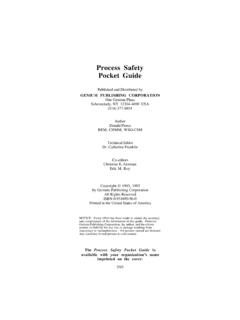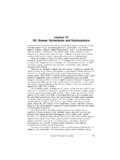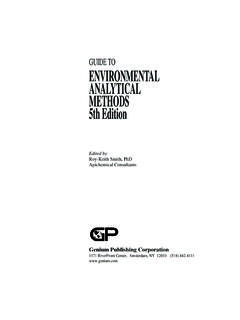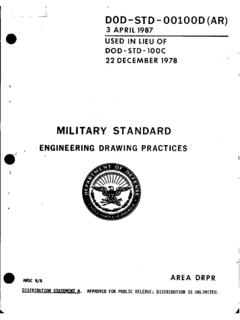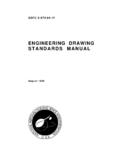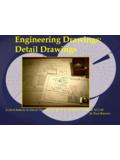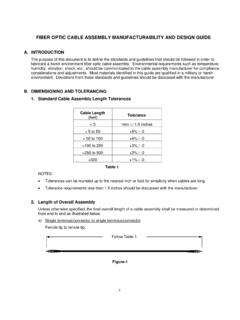Transcription of Dimensioning and Tolerancing Handbook - …
1 Dimensioning and Tolerancing HandbookThe need to make more precise products, the requirements of mass production, and the desire forinterchangeability have resulted in increased importance of clearly defining dimensions and products such as aircraft and automobiles are assembled from parts produced by manycompanies. Only through clear definition of dimensional requirements is it possible for multiple com-panies to efficiently produce parts that will easily assemble and meet their functional United States national standard on Dimensioning and Tolerancing has been revised periodically toinclude methods for defining dimensional requirements for increasingly complex applications. Recentstandards include: USASI , ANSI , ANSI , and ASME This book is based on ASME , but also includes some description of pastpractices for use by anyone who is required to maintain drawings created in compliance with aprevious standard.
2 Past practices are clearly identified when shown within the attempt has been made to accurately describe the requirements of the current standard. Thematerial in this book is intended to make the standardized practices easier to understand. Use of thispublication will help ensure compliance with the related standard. However, should there be anyconflict between this book and a standard, the standard would take Dimensioning and Tolerancing Handbook contains information about the symbology used fordimensions and tolerances, general Dimensioning , general Tolerancing , form tolerances, datums, loca-tion tolerances, orientation tolerances, runout tolerances, and profile tolerances. Calculation methodsand interpretation examples are included. A detailed table of contents makes location of any topic separate list of figures follows the table of contents to assist in locating a graphic example of anyneeded topic.
3 There are over 250 figures to illustrate the concepts explained within the text. An indexat the back of the book is provided to simplify location of specific the AuthorBruce A. Wilson, author and illustrator of the Dimensioning and Tolerancing Handbook , has estab-lished exceptional credentials in the field of Dimensioning and Tolerancing . He has lead implementationof Geometric Dimensioning and Tolerancing (GD&T) throughout the companies of a majorcorporation and served as the technical leader for GD&T implementation on aircraft developmentefforts that included multiple aircraft manufacturing Wilson s industrial experience started with a position as a design drafter in an automated machinetool manufacturing company. He has subsequently held positions as design engineer, design manager,program manager, technology leader for dimensional management, and industrial consultant in thefield of dimensional dimensional management capabilities and technical leadership have had a strong influence on arange of products from the wheels for children s tricycles to laser target designators used by militarypilots.
4 Tomahawk missiles, used at critical times like the Persian Gulf War, demonstrate the accuracyof Mr. Wilson s designs, which all use GD&T to accurately define design requirements and theallowable variations. His other product applications have ranged from miniature gear drives to struc-tural designs for large leader of multiple GD&T training programs for industry, Mr. Wilson has authored several otherpublications on this subject. Through his publications, training programs, and development of GD&Tinstructors, thousands of engineering, manufacturing, and inspection personnel have been a member of the American Society of Mechanical Engineers subcommittee onDimensioning and Tolerancing (ASME ), Mr. Wilson is also a member of ASME , Vice-Chairman of ASME , Chairman of ASME , and a member of the United StatesTAG/ISO/TC10/SC5 on Dimensioning and Tolerancing and the TAG/ISO/TC10/SC10 onEngineering of ContentsiGenium PublishingTABLE OF CONTENTSCHAPTER 3II.
5 COMPLETION LEVEL OF 4 III. BASIS FOR 4IV. GAGING 5V. UNITS OF 6 CHAPTER 9II. GENERAL Tolerancing IDENTIFICATION Datum Feature Datum Feature Target Point and Tolerancing HandbookGenium Material Material of Feature FEATURE CONTROL Control Frame 3 GENERAL DIMENSION 37I. TYPES AND and Number and Number Uses for LINEAR Unit Unit Unit Minutes and FUNDAMENTAL AND of ContentsiiiGenium PublishingDIMENSION Tolerance to the Between Vsible Angle 90 APPLICATION to First Dimension Line OF APPLIED TO SMALL Extension Extension Line VALUE THE TO APPLICATION TO by by arc AND ARC and Tolerancing HandbookGenium PublishingFully Rounded Rounded Diameter and holes and AND AND TUBING LOCATION Coordinate Dimension OF TO INDICATE 4 GENERAL 77I.
6 TOLERANCE APPLICATION APPLICATION TO and Minus AND Limits and Limits and APPLICATION TO A of ContentsvGenium PublishingIII. NUMERICAL on Metric on Inch TOLERANCE LINE Reference SPECIFIED FROM AN From an MATERIAL FORM AT Form of Form Within the MMC Between Features Not Controlled by STATE CONDITION Tolerance at and Specified Material States (1994).. VIRTUAL CONDITION OF A GEARS AND ANGULAR 100 Conical Taper 100 Basic Taper, Basic Diameter, Toleranced 100 Toleranced Taper, Toleranced 100viDimensioning and Tolerancing HandbookGenium PublishingTwo Diameters and 101 FLAT 102 Slope 103 XII. 103 Controlled 104 Previous 104 CHAPTER 107I. 107 Datum 107 Datum 107 Datum 109 Datum Feature 109 Datum Reference 109 DATUM IDENTIFICATION 109 TEMPORARY AND PERMANENT DATUM 110II.
7 DATUM REFERENCE 110 III. ORDER OF 112 SURFACES TO ESTABLISH 113 Primary 113 Tertiary 117 FEATURES OF SIZE TO ESTABLISH 117 Primary 117 Primary Plane, Secondary 118 Primary Axis, Secondary 120 Primary Plane, Secondary Axis, Tertiary 121 Primary Plane, Secondary Axis, Tertiary 122 MULTIPLE DATUM REFERENCE 123IV. IDENTIFICATION OF DATUM 123 IDENTIFICATION OF DATUM 123On Extension 124 Application Using ASME 124 Application Using ANSI 125 Application on a 125 IDENTIFICATION OF DATUM FEATURES OF 125 Section View of a 125 Applied to a 126 Applied to a Slot or 127 Applied to One Hole in a 128 Applied to a Feature Control 128V. DATUM REFERENCES AND DATUM 129 SPECIFIED ORDER OF 130 SIMULATION OF 131 Table of ContentsviiGenium PublishingSurface as a Primary 131 Surface as a Secondary 132 Surface as a Tertiary 134 SIMULATION OF FEATURES OF 136 Hole as Primary Datum (MMC).
8 136 Hole as Secondary Datum (MMC).. 138 Hole as Primary Datum (RFS).. 139 Hole as Secondary Datum (RFS).. 140 TERTIARY DATUMS FOR 141VI. DATUM 143 Target 143 Near Side, Far 143 Number 146 TARGET 146 TARGET TYPE 147 VII. COMPLEX 148 COMPOUND 149 Two on 149 Two 150 PATTERNS OF FEATURES AS 151 Datum Identification and 151 PARTIAL SURFACE (Limited Zone).. 151 STEPPED 151 Datum Plane 152 THREADS AS DATUM 152 SPLINES AND GEARS AS DATUM 152 INCLINED DATUM 152 Simulating Inclined Datum 153 EQUALIZING 153 Equalizing Target 154 REPEATING 154 Individually 154 CHAPTER 157II. 157 Size 157viiiDimensioning and Tolerancing HandbookGenium PublishingMaximum Material 157 Maximum Material Condition of a 157 Maximum Material Condition of a 158 Perfect Form Boundary at 158 Least Material 159 Least Material Condition of a 159 Least Material Condition of a 159No Perfect Form Boundary at 159 Form Controlled by 159 Exceptions to Rule # 160 Straightness Applied to Control Surface 161 Straightness Applied to Control an Axis or Center 161 Straightness of a Flat 161 Straightness of Line Elements on a 162 Straightness of Line Elements on a 162 Straightness of Line Elements on a 163 Axis 165 Axis Straightness of A 165 Axis Straightness of A 166 Applied 166 Applied 167 Straightness of A Center 169 Straightness Per Unit 170 Flatness Control By Size 170 Flatness
9 170 Flatness 171 Flatness Per Unit 172 Circularity Control by Size 172 Specification of 172 Circularity 174 Cylindricity Control By Size 174 Specification Of 174 Cylindricity 174 EXCEPTION TO PERFECT FORM 176 Stock 176 Free State 176 Noted 176 CHAPTER 179 Angularity Applied to A 179 Angularity 180 Table of ContentsixGenium 180 Perpendicularity of A 180 Perpendicularity of A Surface 181 Perpendicularity of A Feature of 181 Perpendicularity on A 182 Interpretation of Perpendicularity on A 184 Virtual Condition of A 184 Bonus Tolerance on 184 Perpendicularity on A 184 Interpretation of Perpendicularity on A 185 Virtual Condition of A 185 Bonus Tolerance on 186 Perpendicularity At Regardless of Feature 186 Perpendicularity on A Rectangular Feature of 189 Parallelism of 189 Parallelism of a Surface 190 Parallelism of 190 Parallelism Effect at 191 MMC Departure Effect on 191 Parallelism Applied to Multiple 191 Referenced Datums Effect on Orientation 191 One Datum 191 Two Datum 193 DIMENSIONS RELATED TO A DATUM 195 Noted Datum Reference 195 Measurements from a Noted Datum Reference 195 CHAPTER 8 POSITION, CONCENTRICITY, AND 199 LOCATION 199II.
10 POSITION 200 Feature Control 201 Position Tolerance 201 Tolerance 201 Material Condition Modifier (1994).. 201 Material Condition Modifier (1982).. 201 Datum 202 Basic Location 202 Locations From Referenced 202 True 202 Hole 204 Comparison of Coordinate and Position 204 Coordinate (plus or minus) 204xDimensioning and Tolerancing HandbookGenium PublishingPosition 206 Round vs. Square Tolerance 208 Calculated Tolerance Zone 208 Square Tolerance 208 Round Tolerance 209 CALCULATION OF POSITION TOLERANCES 210 Floating 210 Calculations for a Floating Fastener 211 One Clearance Hole 211 Two Clearance Hole 212 Unequal Distribution for Floating Fastener 213 Fixed 213 Press Fit and Threaded 213 Fixed Fastener 214 Single Fixed 214 Permitted Location 214 Calculations for a Fixed Fastener 214 Clearance Hole Diameter 215 Position Tolerance for a Dowel 215 Position Tolerance for a 217 Unequal Distribution for Fixed Fastener 217 Plus or Minus ( )


